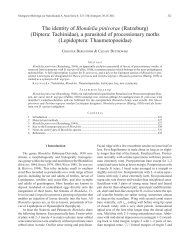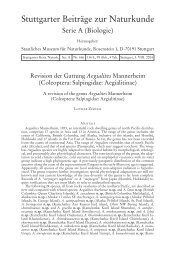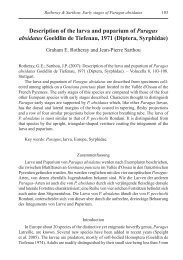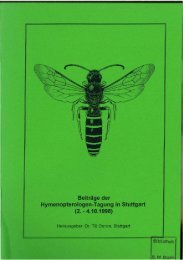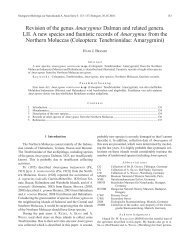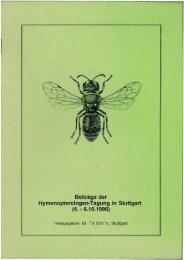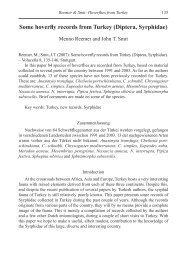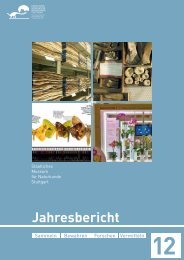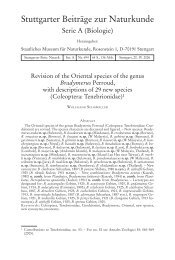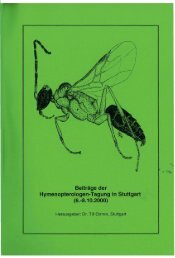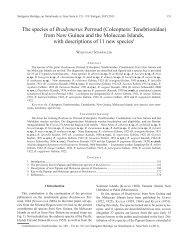448 STUTTGARTER BEITRÄGE ZUR NATURKUNDE A Neue Serie 4TriodontidaeTriodon macropterus Lesson, 1829 – Bourse. – T a x o n o m y :First record from <strong>New</strong> <strong>Caledonia</strong> by FOURMANOIR & LABOUTE(1976: 272). MNHN material. – D i s t r i b u t i o n : NC: 1, [6],[7], 8, [9], [10], [11], [12], 13. Depth: 1–310 m. Mar<strong>in</strong>e species.TetraodontidaeArothron caeruleopunctatus Matsuura, 1994 – Poisson-ballon àtaches bleues. – T a x o n o m y : First record from <strong>New</strong> <strong>Caledonia</strong>by LABOUTE & GRANDPERRIN (2000: 466). – D i s t r i -b u t i o n : NC: [6], [7], 8, [9], [10], 14. Depth: 2–50 m. Mar<strong>in</strong>especies.Arothron fi rmamentum (Temm<strong>in</strong>ck & Schlegel, 1850). – T a x -o n o m y : First record from <strong>New</strong> <strong>Caledonia</strong> by MATSUURA& TYLER (1997: 199–200). NMNZ material. – D i s t r i b u -t i o n : NC: 13; NZ: 19, 23, 26. Depth: 10–360 m. Mar<strong>in</strong>especies.Arothron hispidus (L<strong>in</strong>naeus, 1758) – Ballon à épaule noire. –T a x o n o m y : First record from <strong>New</strong> <strong>Caledonia</strong> as Tetraodonhispidus by FOURMANOIR (1971b: 115); previously reportedas Ovoides implutus by WHITLEY (1961: 65). AMS <strong>and</strong>USNM material. – D i s t r i b u t i o n : NC: 5, 6, 7, 8, [9],[10], 11, 12, 14; AU: 17. Depth: 1–50 m. Transitional water<strong>and</strong> mar<strong>in</strong>e.Arothron immaculatus (Bloch & Schneider [ex Lacepède],1801). – T a x o n o m y : First record from <strong>New</strong> <strong>Caledonia</strong>by WANTIEZ & KULBICKI (1995: 227). – D i s t r i b u t i o n :NC: 5, [6], [7], 8, [9], [10]. Depth: 0–17 m. Transitional water<strong>and</strong> mar<strong>in</strong>e.Arothron manilensis (Procé, 1822) – Ballon à lignes brunes. –T a x o n o m y : First record from <strong>New</strong> <strong>Caledonia</strong> by THOLLOT& KULBICKI (1988: 618); previously misidentified as Arothronimmaculatus (non Bloch & Schneider [ex Lacepède], 1801)by FOURMANOIR & LABOUTE (1976: 266). IRDNC <strong>and</strong> USNMmaterial. – D i s t r i b u t i o n : NC: [6], [7], 8, [9], [10].Depth: 0–20 m. Transitional water <strong>and</strong> mar<strong>in</strong>e.Arothron mappa (Lesson, 1831) – Ballon griffonné. – T a x o n -o m y : First record from <strong>New</strong> <strong>Caledonia</strong> by FOURMANOIR &LABOUTE (1976: 266). IRDNC material. – D i s t r i b u t i o n :NC: 5, [6], [7], 8, [9], [10]. Depth: 1–30 m. Mar<strong>in</strong>e species.Arothron meleagris (Lacepède [ex Commerson], 1798) – Ballonp<strong>in</strong>tade. – T a x o n o m y : First record from <strong>New</strong> <strong>Caledonia</strong>by FOURMANOIR & LABOUTE (1976: 266). – D i s t r i b u -t i o n : NC: 5, 6, 7, 8, [9], [10], [11], [12], 14; AU: 17. Depth:2–24 m. Mar<strong>in</strong>e species.Arothron nigropunctatus (Bloch & Schneider, 1801) – Ballonmaculé. – T a x o n o m y : First record from <strong>New</strong> <strong>Caledonia</strong>by FOURMANOIR & LABOUTE (1976: 268). – D i s t r i b u -t i o n : NC: 1, 5, 6, 7, 8, 9, 10, 11, [12], 14. Depth: 3–25 m.Mar<strong>in</strong>e species.Arothron reticularis (Bloch & Schneider, 1801). – T a x o n o -m y : First record from <strong>New</strong> <strong>Caledonia</strong> as Tetraodon reticularisby FOURMANOIR (1971b: 115). Record from Baie de Pronybased on a photograph taken by R. MYERS (personal communication,March 2010). – D i s t r i b u t i o n : NC: [6], [7], 8,[9], 10. Depth: 1–25 m. Transitional water <strong>and</strong> mar<strong>in</strong>e.Arothron stellatus (Bloch & Schneider, 1801) – Ballon étoilé. –T a x o n o m y : First record from <strong>New</strong> <strong>Caledonia</strong> as Tetraodonstellatus by FOURMANOIR (1971b: 115); subsequentlyreported as Arothron alboreticulatus by FOURMANOIR &L ABOUTE (1976: 266). – D i s t r i b u t i o n : NC: 1, 5, [6], 7,8, [9], [10], [11], [12], 14; AU: 17, [18]; NZ: 23. Depth: 1–58 m.Mar<strong>in</strong>e species.Canthigaster ambo<strong>in</strong>ensis (Bleeker, 1864). – T a x o n o m y :First record from <strong>New</strong> <strong>Caledonia</strong> by EVANS (2006: 116).SMNS material. – D i s t r i b u t i o n : NC: [6], 7, 8, [9], [10],14. Depth: 0–16 m. Mar<strong>in</strong>e species.Canthigaster axiologus Whitley, 1931 – Canthigaster à quatresbarres. – T a x o n o m y : First record from <strong>New</strong> <strong>Caledonia</strong>by RANDALL et al. (2008: 6–7); previously reportedas Canthigaster coronatus (non Vaillant & Sauvage, 1875)by FOURMANOIR & LABOUTE (1976: 269). IRDNC material. –D i s t r i b u t i o n : NC: 1, [6], 7, 8, [9], [10], [11], [12], 14;AU: 17. Depth: 10–76 m. Mar<strong>in</strong>e species.Canthigaster bennetti (Bleeker, 1854). – T a x o n o m y : Firstrecord from <strong>New</strong> <strong>Caledonia</strong> by FOURMANOIR & LABOUTE(1976: 268). IRDNC <strong>and</strong> SMNS material. – D i s t r i b u -t i o n : NC: 1, 5, 6, 7, 8, 9, [10], 11, 12, 14; AU: 17. Depth:0–16 m. Mar<strong>in</strong>e species.Canthigaster callisterna (Ogilby, 1889). – T a x o n o m y : Firstrecord from <strong>New</strong> <strong>Caledonia</strong> (Norfolk Ridge) by MATSUURA& TYLER (1997: 200–201). NMNZ material. – D i s t r i b u -t i o n : NC: 13; AU: 17, 18; NZ: 20, 23. Depth: 230–250 m.Mar<strong>in</strong>e species.Canthigaster compressa (Procé, 1822) – Canthigaster ocellé. –T a x o n o m y : First record from <strong>New</strong> <strong>Caledonia</strong> by RIVATONet al. (1990: 75) <strong>and</strong> KULBICKI & WANTIEZ (1990: 125, 129); previouslyreported as Canthigaster striolatus by FOURMANOIR(1981: 28). IRDNC material. – D i s t r i b u t i o n : NC: 5, [6],[7], 8, [9], 10, [11], [12]. Depth: 5–16 m. Mar<strong>in</strong>e species.Canthigaster epilampra (Jenk<strong>in</strong>s, 1903). – T a x o n o m y : Firstrecord from <strong>New</strong> <strong>Caledonia</strong> by RIVATON et al. (1990: 75) <strong>and</strong>MYERS (1999: 290). – D i s t r i b u t i o n : NC: [6], [7], 8, [9],[10], 14. Depth: 6–60 m. Mar<strong>in</strong>e species.Canthigaster janth<strong>in</strong>optera (Bleeker, 1855). – T a x o n o m y :First record from <strong>New</strong> <strong>Caledonia</strong> by RIVATON et al. (1990: 75)<strong>and</strong> KULBICKI et al. (1994: 39). IRDNC, SMNS <strong>and</strong> USNMmaterial. – D i s t r i b u t i o n : NC: 1, 5, 6, 7, 8, [9], [10], [11],[12], 14; AU: 17. Depth: 0–30 m. Mar<strong>in</strong>e species.Canthigaster ocellic<strong>in</strong>cta Allen & R<strong>and</strong>all, 1977. – T a x o n o -m y : Recorded from <strong>New</strong> <strong>Caledonia</strong> <strong>in</strong> orig<strong>in</strong>al descriptionby ALLEN & RANDALL (1977: 485–486). MNHN material. –D i s t r i b u t i o n : NC: [6], [7], 8, [9], [10]. Depth: 10–53 m.Mar<strong>in</strong>e species.Canthigaster papua (Bleeker, 1848). – T a x o n o m y : Firstrecord from <strong>New</strong> <strong>Caledonia</strong> by RANDALL et al. (1997: 477).SMNS material. – D i s t r i b u t i o n : NC: [6], [7], 8, [9],[10], [11], 12. Depth: 2–50 m. Mar<strong>in</strong>e species.Canthigaster rivulata (Temm<strong>in</strong>ck & Schlegel, 1850). – T a x -o n o m y : First record from <strong>New</strong> <strong>Caledonia</strong> as Canthigasterrivulatus by RIVATON (1989: 147). MNHN material. – D i s -t r i b u t i o n : NC: 1, 5, [6], [7], 8, [9], [10], 11, [12], 14.Depth: 0–350 m. Mar<strong>in</strong>e species.Canthigaster sol<strong>and</strong>ri (Richardson [ex Sol<strong>and</strong>er], 1845). – T a x -o n o m y : First record from <strong>New</strong> <strong>Caledonia</strong> by FOURMANOIR& LABOUTE (1976: 269). SMNS material. – D i s t r i b u -t i o n : NC: 6, 7, 8, 9, [10], 11, 12, 14. Depth: 0–36 m. Mar<strong>in</strong>especies.Canthigaster valent<strong>in</strong>i (Bleeker, 1853) – Canthigaster à sellesnoires. – T a x o n o m y : First record from <strong>New</strong> <strong>Caledonia</strong> by
FRICKE ET ALII, CHECKLIST OF FISHES OF NEW CALEDONIA 449FOURMANOIR & LABOUTE (1976: 269). AMS, IRDNC, SMNS<strong>and</strong> USNM material. – D i s t r i b u t i o n : NC: 1, 5, 6, 7, 8, 9,10, 11, 12, 14; AU: 17. Depth: 0–91 m. Mar<strong>in</strong>e species.Chelonodon patoca (Hamilton, 1822). – T a x o n o m y : Firstrecord from <strong>New</strong> <strong>Caledonia</strong> (Gr<strong>and</strong>e Terre) by FRICKE &KULBICKI (2006: 357). AMS material. – D i s t r i b u t i o n :NC: [6], [7], 8, [9], [10]. Depth: 4–60 m. Freshwater, transitionalwater <strong>and</strong> mar<strong>in</strong>e.Lagocephalus sceleratus (Gmel<strong>in</strong>, 1789) – Ballon à b<strong>and</strong>es argentées,ballon scélérat. – T a x o n o m y : First record from<strong>New</strong> <strong>Caledonia</strong> as Pleuranacanthus scleratus by WHITLEY(1961: 65). AMS <strong>and</strong> IRDNC material. – D i s t r i b u t i o n :NC: 1, 5, [6], 7, 8, [9], [10], [11], [12], 14; AU: 17. Depth: 18–100 m. Mar<strong>in</strong>e species.Sphoeroides pachygaster (Müller & Troschel <strong>in</strong> Schomburgk,1848). – T a x o n o m y : First record from <strong>New</strong> <strong>Caledonia</strong>by RIVATON (1989: 156); previously reported as Tetraodontestud<strong>in</strong>eus (non L<strong>in</strong>naeus, 1758) by PLESSIS & FOURMANOIR(1966c: 144). MNHN <strong>and</strong> NMNZ material. – D i s t r i b u -t i o n : NC: 1, 2, [6], [7], 8, [9], [10], [11], [12], 13. Depth: 50–480 m. Mar<strong>in</strong>e species.Torquigener brevip<strong>in</strong>nis (Regan, 1903). – T a x o n o m y : Firstrecord from <strong>New</strong> <strong>Caledonia</strong> by MATSUURA & TYLER (1997:203). MNHN <strong>and</strong> NSMT material. – D i s t r i b u t i o n :NC: 5. Depth: 20–100 m. Mar<strong>in</strong>e species.Torquigener hypselogeneion (Bleeker, 1852). – T a x o n o m y :First record from <strong>New</strong> <strong>Caledonia</strong> as Amblyrhynchotes hypselogeneionby RIVATON et al. (1990: 75) <strong>and</strong> KULBICKI & WAN-TIEZ (1990: 125). IRDNC material. – D i s t r i b u t i o n : NC:5, [6], [7], 8, [9], [10]. Depth: 18–22 m. Mar<strong>in</strong>e species.Torquigener pallimaculatus Hardy, 1983. – T a x o n o m y : Firstrecord from <strong>New</strong> <strong>Caledonia</strong> by RIVATON (1989: 147). IRDNCmaterial. – D i s t r i b u t i o n : NC: 1. Depth: 7–78 m. Mar<strong>in</strong>especies.Torquigener tuberculiferus (Ogilby, 1912). – T a x o n o m y :First record from <strong>New</strong> <strong>Caledonia</strong> (Chesterfield Isl<strong>and</strong>s) byKULBICKI et al. (1994: 39). IRDNC material. – D i s t r i b u -t i o n : NC: 1. Depth: 73–80 m. Mar<strong>in</strong>e species.Tylerius sp<strong>in</strong>osissimus (Regan, 1908). – T a x o n o m y : Firstrecord from <strong>New</strong> <strong>Caledonia</strong> by MATSUURA & TYLER (1997:204–205). MNHN <strong>and</strong> NSMT material. – D i s t r i b u -t i o n : NC: 5, [6], [7], [8], 9, [10]. Depth: 250–435 m. Mar<strong>in</strong>especies.DiodontidaeChilomycterus reticulatus (L<strong>in</strong>naeus, 1758). – T a x o n o m y :<strong>New</strong> record from <strong>New</strong> <strong>Caledonia</strong> (Gr<strong>and</strong>e Terre), based onvideo seen on Youtube taken near Nouméa (Anonymous2009a), <strong>and</strong> on one specimen observed near Koné by M.KULBICKI. – D i s t r i b u t i o n : NC: [6], [7], 8, [9], [10], [11],[12]; AU: 17; NZ: 23. Depth: 20–100 m. Mar<strong>in</strong>e species.Cyclichthys orbicularis (Bloch, 1785). – T a x o n o m y : Firstrecord from <strong>New</strong> <strong>Caledonia</strong> by RIVATON et al. (1990: 37) <strong>and</strong>LEIS (2001: 3662). IRDNC material. – D i s t r i b u t i o n :NC: 5, [6], [7], 8, [9], [10], [11], [12]; AU: 17. Depth: 9–170 m.Mar<strong>in</strong>e species.Cyclichthys spilostylus (Leis & R<strong>and</strong>all, 1982). – T a x o n o m y :First record from <strong>New</strong> <strong>Caledonia</strong> by RIVATON et al. (1990: 37)<strong>and</strong> THOLLOT (1996a: 15). – D i s t r i b u t i o n : NC: [6], [7],8, [9], [10]. Depth: 3–90 m. Mar<strong>in</strong>e species.Diodon holocanthus L<strong>in</strong>naeus, 1758 – Poisson porc-épic. – T a x -o n o m y : First record from <strong>New</strong> <strong>Caledonia</strong> by RIVATON etal. (1990: 37) <strong>and</strong> KULBICKI et al. (1994: 39). USNM material.– D i s t r i b u t i o n : NC: 1, [6], [7], 8, [9], 10, [11], [12];AU: 17. Depth: 0–200 m. Mar<strong>in</strong>e species.Diodon hystrix (L<strong>in</strong>naeus, 1758) – Poisson porc-épic. – T a x -o n o m y : First record from <strong>New</strong> <strong>Caledonia</strong> by FOURMANOIR& LABOUTE (1976: 270). – D i s t r i b u t i o n : NC: 1, 5, 6, 7,8, 9, 10, 11, [12], 14; AU: 17, 18; NZ: 20. Depth: 0–50 m. Mar<strong>in</strong>especies.Diodon liturosus Lacepède <strong>in</strong> Shaw, 1804 – Poisson porc-épic.– T a x o n o m y : First record from <strong>New</strong> <strong>Caledonia</strong> byF OURMANOIR & LABOUTE (1976: 270). – D i s t r i b u t i o n :NC: 5, 6, 7, 8, [9], [10], 14. Depth: 0–90 m. Mar<strong>in</strong>e species.Lophodiodon calori (Bianconi, 1855). – T a x o n o m y : Firstrecord from <strong>New</strong> <strong>Caledonia</strong> by RIVATON et al. (1990: 37),R IVATON & RICHER DE FORGES (1990: 28), <strong>and</strong> FRICKE &K ULBICKI (2006: 357). IRDNC material. – D i s t r i b u -t i o n : NC: [6], [7], 8, [9], [10]. Depth: 0–100 m. Mar<strong>in</strong>especies.MolidaeMasturus lanceolatus (Liénard, 1840). – T a x o n o m y : Firstrecord from <strong>New</strong> <strong>Caledonia</strong> by FOURMANOIR (1976: 84).– D i s t r i b u t i o n : NC: [6], [7], 8, [9], [10]. Depth: 50–670 m. Mar<strong>in</strong>e species.Mola mola (L<strong>in</strong>naeus, 1758). – T a x o n o m y : First record from<strong>New</strong> <strong>Caledonia</strong> by FOURMANOIR (1971b: 115). – D i s t r i b u -t i o n : NC: [6], [7], 8, [9], [10], [11], [12]; NZ: 20. Depth:0–480 m. Mar<strong>in</strong>e species.Mola ramsayi (Giglioli, 1883). – T a x o n o m y : First recordfrom <strong>New</strong> <strong>Caledonia</strong> by FRICKE & KULBICKI (2006: 357); previouslyreported as Mola sp. by FOURMANOIR (1971b: 115). –D i s t r i b u t i o n : NC: [6], [7], 8, [9], [10], [11], [12]; AU:17; NZ: 23, 24, 25. Depth: 0–300 m. Mar<strong>in</strong>e species.Ranzania laevis (Pennant, 1776). – T a x o n o m y : First recordfrom <strong>New</strong> <strong>Caledonia</strong> by FOURMANOIR (1971b: 115). – D i s -t r i b u t i o n : NC: [6], [7], 8, [9], [10], [11], [12]; NZ: 23.Depth: 0–140 m. Mar<strong>in</strong>e species.4 The fish fauna <strong>of</strong> <strong>New</strong> <strong>Caledonia</strong> <strong>and</strong> its endemismThe fish fauna <strong>of</strong> <strong>New</strong> <strong>Caledonia</strong> comprises a total <strong>of</strong>2328 species <strong>in</strong> 246 families. Eight <strong>of</strong> <strong>the</strong>se species arenot native, but have been <strong>in</strong>troduced. Five fish families arerepresented only by <strong>in</strong>troduced species. The native fishfauna <strong>of</strong> <strong>New</strong> <strong>Caledonia</strong> <strong>the</strong>refore consists <strong>of</strong> 2320 species<strong>in</strong> 241 families. The largest families are <strong>the</strong> Gobiidae (192native species, 8.3 % <strong>of</strong> <strong>the</strong> native species), Labridae (129species, 5.6 %), Pomacentridae (113 species, 4.9 %), Serranidae(95 species, 4.1 %), Apogonidae (81 species, 3.5 %),Blenniidae (64 species, 2.8 %), Macrouridae (52 species,2.2 %), Myctophidae (52 species, 2.2 %), Scorpaenidae(52 species, 2.2 %), Muraenidae (49 species, 2.1 %), Lutjanidae(43 species each, 1.9 %), Carangidae (42 species,1.8 %), Syngnathidae (43 species, 1.9 %) <strong>and</strong> Acanthuridae(40 species, 1.7 %). Typically for remote tropical isl<strong>and</strong>
- Page 3 and 4:
FRICKE ET ALII, CHECKLIST OF FISHES
- Page 5 and 6:
FRICKE ET ALII, CHECKLIST OF FISHES
- Page 7 and 8:
FRICKE ET ALII, CHECKLIST OF FISHES
- Page 9 and 10:
FRICKE ET ALII, CHECKLIST OF FISHES
- Page 11 and 12:
FRICKE ET ALII, CHECKLIST OF FISHES
- Page 13 and 14:
FRICKE ET ALII, CHECKLIST OF FISHES
- Page 15 and 16:
FRICKE ET ALII, CHECKLIST OF FISHES
- Page 17 and 18:
FRICKE ET ALII, CHECKLIST OF FISHES
- Page 19 and 20:
FRICKE ET ALII, CHECKLIST OF FISHES
- Page 21 and 22:
FRICKE ET ALII, CHECKLIST OF FISHES
- Page 23 and 24:
FRICKE ET ALII, CHECKLIST OF FISHES
- Page 25 and 26:
FRICKE ET ALII, CHECKLIST OF FISHES
- Page 27 and 28:
FRICKE ET ALII, CHECKLIST OF FISHES
- Page 29 and 30:
FRICKE ET ALII, CHECKLIST OF FISHES
- Page 31 and 32:
FRICKE ET ALII, CHECKLIST OF FISHES
- Page 33 and 34:
FRICKE ET ALII, CHECKLIST OF FISHES
- Page 35 and 36:
FRICKE ET ALII, CHECKLIST OF FISHES
- Page 37 and 38:
FRICKE ET ALII, CHECKLIST OF FISHES
- Page 39 and 40:
FRICKE ET ALII, CHECKLIST OF FISHES
- Page 41 and 42:
FRICKE ET ALII, CHECKLIST OF FISHES
- Page 43 and 44:
FRICKE ET ALII, CHECKLIST OF FISHES
- Page 45 and 46:
FRICKE ET ALII, CHECKLIST OF FISHES
- Page 47 and 48:
FRICKE ET ALII, CHECKLIST OF FISHES
- Page 49 and 50:
FRICKE ET ALII, CHECKLIST OF FISHES
- Page 51 and 52:
FRICKE ET ALII, CHECKLIST OF FISHES
- Page 53 and 54:
FRICKE ET ALII, CHECKLIST OF FISHES
- Page 55 and 56:
FRICKE ET ALII, CHECKLIST OF FISHES
- Page 57 and 58: FRICKE ET ALII, CHECKLIST OF FISHES
- Page 59 and 60: FRICKE ET ALII, CHECKLIST OF FISHES
- Page 61 and 62: FRICKE ET ALII, CHECKLIST OF FISHES
- Page 63 and 64: FRICKE ET ALII, CHECKLIST OF FISHES
- Page 65 and 66: FRICKE ET ALII, CHECKLIST OF FISHES
- Page 67 and 68: FRICKE ET ALII, CHECKLIST OF FISHES
- Page 69 and 70: FRICKE ET ALII, CHECKLIST OF FISHES
- Page 71 and 72: FRICKE ET ALII, CHECKLIST OF FISHES
- Page 73 and 74: FRICKE ET ALII, CHECKLIST OF FISHES
- Page 75 and 76: FRICKE ET ALII, CHECKLIST OF FISHES
- Page 77 and 78: FRICKE ET ALII, CHECKLIST OF FISHES
- Page 79 and 80: FRICKE ET ALII, CHECKLIST OF FISHES
- Page 81 and 82: FRICKE ET ALII, CHECKLIST OF FISHES
- Page 83 and 84: FRICKE ET ALII, CHECKLIST OF FISHES
- Page 85 and 86: FRICKE ET ALII, CHECKLIST OF FISHES
- Page 87 and 88: FRICKE ET ALII, CHECKLIST OF FISHES
- Page 89 and 90: FRICKE ET ALII, CHECKLIST OF FISHES
- Page 91 and 92: FRICKE ET ALII, CHECKLIST OF FISHES
- Page 93 and 94: FRICKE ET ALII, CHECKLIST OF FISHES
- Page 95 and 96: FRICKE ET ALII, CHECKLIST OF FISHES
- Page 97 and 98: FRICKE ET ALII, CHECKLIST OF FISHES
- Page 99 and 100: FRICKE ET ALII, CHECKLIST OF FISHES
- Page 101 and 102: FRICKE ET ALII, CHECKLIST OF FISHES
- Page 103 and 104: FRICKE ET ALII, CHECKLIST OF FISHES
- Page 105 and 106: FRICKE ET ALII, CHECKLIST OF FISHES
- Page 107: FRICKE ET ALII, CHECKLIST OF FISHES
- Page 111 and 112: FRICKE ET ALII, CHECKLIST OF FISHES
- Page 113 and 114: FRICKE ET ALII, CHECKLIST OF FISHES
- Page 115 and 116: FRICKE ET ALII, CHECKLIST OF FISHES
- Page 117 and 118: FRICKE ET ALII, CHECKLIST OF FISHES
- Page 119 and 120: FRICKE ET ALII, CHECKLIST OF FISHES
- Page 121 and 122: FRICKE ET ALII, CHECKLIST OF FISHES
- Page 123: FRICKE ET ALII, CHECKLIST OF FISHES




